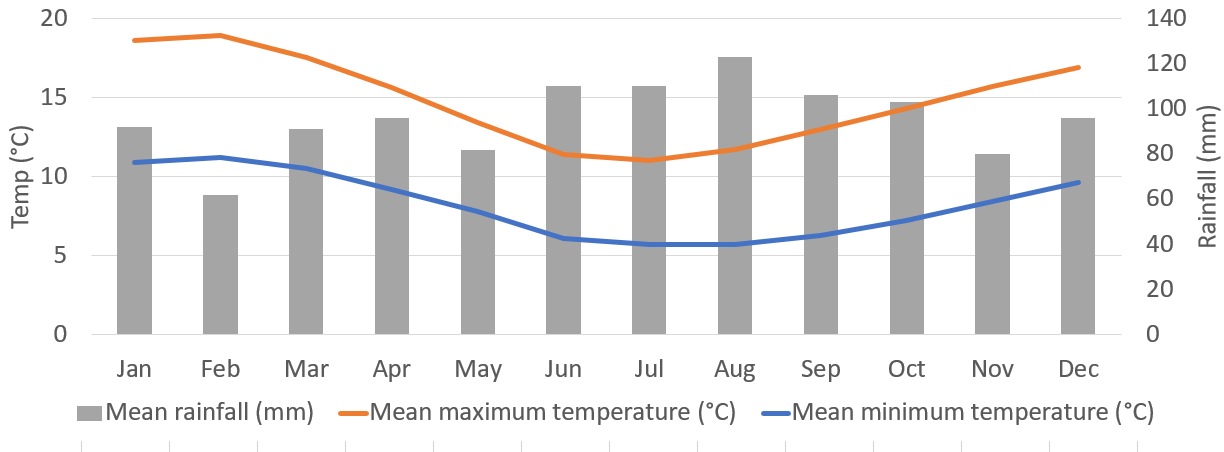WHERE IS THE THREE CAPES WALK LOCATED?
The Three Capes walk is on the Tasman Peninsula, which is located in the south-east of Tasmania. On the way to the peninsula, you will drive through some of Tasmania’s rich heritage, rolling vineyards and hills. It is approximately 100 kms from CBD Hobart a travel time of about 90 minutes by vehicle.
Please Note: The official Three Capes Track route does not go to all three Capes, just two of them, we also only walk to two of the Capes. Please read the itinerary or see the Highlights for further information.
WHAT LEVEL OF FITNESS DO YOU RECOMMEND?
We expect people to have a reasonable level of fitness. Regular physical exercise in the lead up to the trip is recommended. This can be from walking, cycling, going to the gym or a combination of these. You will walk an average of 11kms each day. Some of the walking has an up and down component, mixed in with flat and undulating sections of track. If you exercise regularly, have a moderate to good walking fitness level and feel capable of walking up to 5 to 6 hours a day, this walk is for you.
HOW CHALLENGING IS THE WALK?
Most of the tracks are in first rate condition. Some of the walks include sections of walking up and down again, but this is compensated by shorter walking distances overall. Full day walks average 10-15 kms. There are great opportunities for fit walkers to challenge themselves as there is plenty of additional walking that you can take up.
DO YOU HAVE AN INCENTIVE PROGRAM?
Walking with Auswalk gives you exclusive access to our incentive program. We love our Auswalkers and want to make it easy for you to return for another holiday. Here’s what we offer:
- Frequent Walker Points: Just by going on a holiday with us, you will earn 100 Frequent Walker Points which you can redeem for a $100 discount (per person) off your next Auswalk trip. These points are valid for 2 years. If you use your points on a new booking of a value greater than $2300 per person, and within 2 months of completing your previous holiday, we will double the points for you. This means that you will have 200 Frequent Walker Points to redeem as a $200 discount (per person) off your new booking. Please note: You can only use a maximum of 1 set of double points ($200) per new booking and points can’t be used in conjunction with any other offer.
- Save if your group is 5 or more with a 5% discount for all walkers. Full payment will be invoiced when booking. At the time of final payment the discount will be applied when the numbers are confirmed. Not to be used in conjunction with any other offer.
DO I HAVE TO PAY A SINGLE SUPPLEMENT FEE IF I'M A SOLO WALKER?
Australian hotel accommodations (like the ones we use) charge the same, or just about the same price, regardless of whether there is one or two people in the room. This means that to cover the cost of the accommodation for your trip we do need to pass on a single supplement surcharge. This isn’t a cost that we make any margin on and it is simply to cover the fact that the total room cost isn’t being apportioned over two walkers.
CAN YOU RECOMMEND ANY PRE/POST WALK ACCOMMODATION?
There are numerous accommodations in Hobart. We suggest staying close to Salamanca Place and the waterfront. The options are vast and will depend entirely on your budget.
You may also like to visit the TripAdvisor and search for other options to best suit your budget and lifestyle.
WHAT LEVEL OF ACCOMMODATION DO YOU PROVIDE?
All the accommodations have been chosen to reflect the character of the region. Accommodations will range from small local hotels to lodges; you can be assured that wherever you stay, you will be warmly welcomed. Most importantly, the accommodations are in great locations and have all the necessary facilities to make your stay as comfortable as possible.
WHAT WILL BE INCLUDED IN MY PRE-DEPARTURE PACK?
You will receive an information pack before departure, including:
- Map, Map case, luggage tag and pen
- Insulated lunch bag, expandable lunch box, reusable cutlery and other useful bits and pieces
- Comprehensive track notes developed by and authored by Auswalk with all the detail that will be needed to walk the Three Capes Walk.
CAN YOU CATER FOR SPECIAL DIETARY REQUIREMENTS?
On our walks, we can cater for specific dietary requirements. Please kindly provide this information when completing your booking form and only provide us with a list of your allergies or those food items that you absolutely cannot eat.
WILL I HAVE WI-FI ACCESS?
Wi-Fi access will be available at the accommodations along the track.
WHAT WILL THE WEATHER BE LIKE?
See the Bureau of Meteorology for information about temperatures and rainfall ahead of time to ensure proper clothing. Spring and autumn are a great time to walk on the Tasman Peninsula. Summer can be a little warmer but with average temperatures of only 18 degrees. Winter is often written off as a time not to visit Tasmania, let alone walk because of the rain. Layers will be your best friend in these parts. However, if you look at the mean average rainfall it isn’t that much more than in summer. The average temperature in winter does, however, fall to 11 degrees so come prepared with warm clothes and good rain gear (realistically year round). See gear advice section in FAQ’s for more information.
WHAT WILDLIFE MAY I ENCOUNTER IN THIS REGION?
An abundance of animals and birds exist in this region. Wallabies, echidnas, wombats, pygmy, brushtail and ringtail possums, the Tasmanian bettong, long nosed potoroo, blue tongue lizards and Tasmanian devils (they are actually quite shy) to name a few.
Bird life includes Tasmanian rosellas, Tasmanian native hens and White-bellied sea eagles which breed on the peninsula.
Snakes are also most likely to be around in the summer months. They will usually move away from the sound and vibration of human activity. Did you know that Tasmania has only 3 species of snakes? Tiger, lowland copperhead and white-lipped snakes.
HOW IMPORTANT IS IT TO KEEP TO THE WALKING TRACKS?
By keeping to the walking track it reduces erosion, protects native vegetation and the spread of cinnamon fungus (it is a lethal disease that has serious consequences for many Australian habitats). You are also less likely to have a close encounter with snakes, ants, leeches, wasps, bees and ticks.
WHAT ARE YOUR LUGGAGE REQUIREMENTS?
You are allowed up to 23kgs of luggage, please no heavier as it may cause problems. Please also be aware that you may have to move your luggage to and from your room on some occasions, however, your luggage is transferred while you walk.
WILL I NEED WATERPROOF CLOTHING?
A waterproof jacket is ideal. It serves two functions – to keep you dry and to keep the wind out. Cheaper plastic or nylon raincoats are good for keeping the rain out, but unfortunately, they do not breathe meaning that you’ll still get wet from condensation and not really suitable for any walk.
By far the best jackets are made from waterproof and breathable fabrics such as Gore-Tex. These wick your body moisture through the Gore-Tex material to the outside of the jacket through one-way pores. Goretex and other similar jackets aren’t cheap, but most of the quality outdoor equipment stores have sales where prices can often be reduced by substantial amounts. And they last a lifetime! Your waterproof jacket is a practical item, designed to keep you warm, dry and comfortable in the bush and warm in areas where there is a risk of being cold.
WHAT CLOTHING SHOULD I PACK FOR COLD CONDITIONS?
Depending on the time of year you are visiting it can get quite cold, especially at night. A warm jumper is a must. The best material these days is polar fleece or equivalents as they are lightweight and dry very quickly if they get wet. Wool, on the other hand, is heavy and takes a long time to dry. Cotton is not appropriate. A warm hat is also desirable. Did you know that you lose 40% of your body heat through your head? So if you’re feeling cold, don a hat and feel the difference.
WHAT CLOTHING SHOULD I PACK FOR WALKING THROUGHOUT THE DAY?
We recommend thin synthetic materials for walking. Cotton can get damp from perspiration.
Shirts should have collars and sleeves to help prevent sunburn. Long sleeves that can be either rolled up or rolled down are a good idea. Light colours will keep you cooler. Specialist shirts have vents to allow for airflow.
Shorts are great for hot weather, but remember to use plenty of sunscreen. Long trousers are great for sun protection and also for cooler weather. Trousers that have “zip off” legs are a good compromise.
A sun hat is essential. Choose a hat with a brim all the way round as this keeps off more heat and sun than either baseball caps or a soft floppy cotton hats. Good hats also come with some mesh ventilation in the middle and a chinstrap to keep it on when the wind blows. Choose a hat that packs easily into your case and daypack. Sunglasses are also essential.
WHAT FOOTWEAR DO YOU RECOMMEND FOR WALKING?
We strongly recommend wearing proper hiking boots or shoes as they provide added ankle support. One thing is for sure if you buy a new pair of walking boots/shoes make sure you break them in before you come on holiday.
Here are some further considerations:
Boots versus walking shoes – that’s largely an issue of personal preference. Walking shoes don’t provide anywhere near as much ankle support as boots though.
The weight of the footwear is important. You only need something suitable for day hikes on tracks – not to climb Mt Everest in! There’s an old saying that 100 grams on your feet is equivalent to 500 on your back.
The shoes should wrap around the foot with an even, snug hold over all parts of your foot. You should look for comfort across the balls of the feet. Your toes should not press together or touch the end of the boot – this is especially important for downhill walking. Your heel should not move inside the boot when you walk. And a laced up boot should not put pressure on the top of your foot or hurt your ankle.
Leather has been the long-time favourite with many walkers but these days leather is generally only used in heavier boots, which are mostly not necessary for day walks. Most light – medium-weight boots are of good quality and have synthetic uppers. These are durable but do not keep the water out. If you can pay some more, have a look at boots with a waterproof membrane such as Gore-Tex. The membrane is a very clever product built into the boot material so, though it can’t be seen, it lasts for the life of the boot. Dry feet will be more comfortable, smell less, and be less likely to blister if conditions get tough.
The soles of the boots are extremely important. Look for soles that are thick enough to protect your feet against sharp rocks that might press into the sole, and with a chunky pattern that will provide better grip on slippery tracks. A Vibram sole is good quality – look for the yellow brand on the sole of the boots.
Finally, we often see people who are wearing cheap, ill-fitting, loose, sloppy socks, which is an absolute recipe for disaster! Wear socks that fit firmly. Spend that bit extra and buy socks with shaped heels and good cushioning – your feet with thank you at the end of the day! Some people like to wear one pair of socks, others prefer two pair…..it is up to you. Once again, avoid loose socks that are too big.
DO YOU RECOMMEND GAITERS FOR THIS TRIP?
We don’t believe gaiters are essential for this walk, however, you may decide otherwise. Gaiters are designed to keep rain, grass seeds, sand, mud, leeches and other unwanted items out of the top of your boots. They come in a full range of sizes from huge mountaineering styles through to short, lightweight ones. Most of them wrap over the boot laces, around the tops of boots and upwards over the lower part of your legs.
Sensible, practical gaiters should have some stiffness, so they will sit upright around the lower part of your legs, and not slip down. Also, they should go on and off without needing to remove your boots. Gaiters also provide useful leg & sock protection whenever there are scratchy plants over the track or grasses full of seeds.
DO YOU RECOMMEND WALKING POLES FOR THIS TRIP?
Yes we do. More and more walkers are discovering the benefits of using one or two walking poles. Poles can provide valuable support when walking on uneven ground, or where there is an elevation. They can significantly reduce jarring on knees and ankles when walking downhill.
There are several different styles of handles, so you can find a comfortable grip. Look for a stick with a spring mechanism built into it, which will reduce jarring on wrists and elbows. Your new poles will no doubt travel in your suitcase so make sure it collapses small enough to fit. Everyone can benefit from the use of walking poles, for walking further, exercising/strengthening the upper body and relieving the pounding on the knees and other joints.
WILL I HAVE TO CARRY A HEAVY PACK?
All of our holidays are pack free experiences with all the logistics being organised for you. All your luggage will be moved for you so you won’t need to carry a heavy pack. All you will need to carry with you is your day pack.
WHAT IS AN IDEAL DAY PACK FOR WALKING?
The best piece of advice we can give is to make sure it’s big enough! As a minimum, you need to fit in your lunch, water bottle/s, wet weather gear, warm jumper, camera and other personal bits and pieces. A larger pack weighs marginally more and costs very little extra and you’re unlikely to regret it.
Well-padded shoulder straps are a must as your pack is inevitably going to feel heavier as the day goes on. Padded waist/hip belts are also very useful as they help take some of the load off your shoulders. A chest strap is available on most good packs these days and it will stop the pack from sliding around on your back whilst you bend over or walk on uneven terrain.
Several pockets or sections can also be handy, allowing you quick access to things like sunscreen, your water bottle or snacks.
Most packs are not waterproof, so it’s always a good idea to line the pack with a heavy-duty plastic bag. You can also buy a pack cover, which does an excellent job of keeping most of the rain out.
Some daypacks have a curved back and this allows more air to circulate, a fabulous idea for comfort. Whilst other hikers have wet backs, with one of these daypacks your back will remain dry.
DO YOU RECOMMEND TRAVEL INSURANCE?
Please remember that it is far better to have travel insurance than not, particularly if you find yourself in the unfortunate position of having to cancel the walk. This way, you are covered.
While our Auswalk and/or service partners do all that we can to ensure that you and your possessions are safe and well-cared-for throughout your holiday, accidents can occasionally happen. It is your responsibility to ensure that any luggage being transported between accommodations along the trail is safely packed and does not contain any valuable and/or fragile items such as laptops, tablets, cameras, mobile phones or glass. Please protect yourself and your luggage and its contents with a suitable holiday insurance policy.
This insurance should also cover non-refundable costs should you have to cancel your trip due to unexpected personal circumstances.




